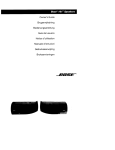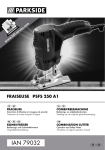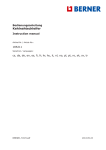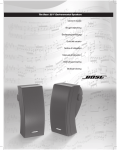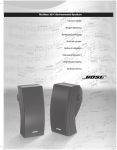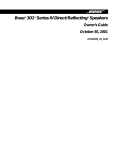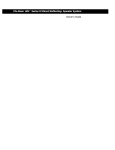Download Bose VCS-30 Technical information
Transcript
257528_00 VCS Eng.book Page 1 Monday, July 2, 2001 8:45 AM Bose® Home Theater Speakers Owner’s Guide Brugervejledning Bedienungsanleitung Guía del usuario Notice d’utilisation Manuale d’istruzioni Gebruiksaanwijzing Bruksanvisningen VCS-10® Center Speaker VCS-30® Series II Center/Surround Speaker System 257528_00 VCS Eng.book Page 2 Monday, July 2, 2001 8:45 AM 2 257528_00 VCS Eng.book Page 3 Monday, July 2, 2001 8:45 AM Where to find … 14 14 14 15 15 15 Espanol Reference . . . . . . . . . . . . . . . . . . . . . . . . . . . . . . . . . . . . . . . . Troubleshooting . . . . . . . . . . . . . . . . . . . . . . . . . . . . . . . . Customer service . . . . . . . . . . . . . . . . . . . . . . . . . . . . . . . Cleaning speakers . . . . . . . . . . . . . . . . . . . . . . . . . . . . . . Warranty period . . . . . . . . . . . . . . . . . . . . . . . . . . . . . . . . Technical information . . . . . . . . . . . . . . . . . . . . . . . . . . . Deutsch 12 12 12 12 12 13 13 Dansk Adjusting Your Surround Sound Settings . . . . . . . . . . . . . . . For realistic home theater sound . . . . . . . . . . . . . . . . . . . How to set your Pro-Logic receiver . . . . . . . . . . . . . . . . . To use the test tone . . . . . . . . . . . . . . . . . . . . . . . . . To balance the bass and treble . . . . . . . . . . . . . . . . . How to set your Dolby Digital receiver . . . . . . . . . . . . . . If the sound is interrupted . . . . . . . . . . . . . . . . . . . . . . . . English Setting Up . . . . . . . . . . . . . . . . . . . . . . . . . . . . . . . . . . . . . . . 4 Before you begin . . . . . . . . . . . . . . . . . . . . . . . . . . . . . . . 4 Unpack the carton . . . . . . . . . . . . . . . . . . . . . . . . . . . . . . 4 Place the center speaker . . . . . . . . . . . . . . . . . . . . . . . . . 6 Position your surround speakers . . . . . . . . . . . . . . . . . . . 7 Connect the speakers . . . . . . . . . . . . . . . . . . . . . . . . . . . 8 Choosing speaker cord . . . . . . . . . . . . . . . . . . . . . . . 8 Be sure to use the cord properly . . . . . . . . . . . . . . . 8 Make the connections . . . . . . . . . . . . . . . . . . . . . . . . 9 Check the connections . . . . . . . . . . . . . . . . . . . . . . . . . . 10 Mounting your speakers on a wall . . . . . . . . . . . . . . . . . . 11 Francais Italiano Nederlands For your records Serial numbers are located on the back of each speaker. Center speaker serial number: _____________________________________ Surround speaker serial numbers: _______________and _______________ Dealer name: ____________________________________________________ Svenska Dealer phone: _________________ Purchase date: ____________________ We suggest you keep your sales receipt and warranty card together with this owner’s guide. ©2001 Bose Corporation. No part of this work may be reproduced, modified, distributed or otherwise used without prior written permission. Dolby is a trademark of Dolby Laboratories Licensing Corporation. 3 257528_00 VCS Eng.book Page 4 Monday, July 2, 2001 8:45 AM Setting Up English Before you begin Thank you for choosing Bose® home theater speakers. Both the VCS-10® center speaker and the VCS-30® Series II center/surround speaker system are engineered specifically for use with video soundtracks. They are designed to make the most of audio for video (A/V) surround sound receivers or amplifiers with five amplified speaker outputs. In either package you purchased, there is a center speaker. Its magnetic shielding allows you to put this speaker directly on, above, or below your video screen without causing screen discoloration. There it will deliver clear, crisp soundtrack reproduction from the center channel. Other speakers at the front of your room provide the left and right video sound. In additon to one center speaker, the VCS-30 Series II system includes two surround speakers. They are designed for use at the rear of your room. Advanced design brackets included in this package make the surround speakers simple to mount on a wall. Please read and follow the instructions in this guide. They will help you set up and use your new home theater speakers for the fullest listening and viewing enjoyment. Unpack the carton Carefully unpack the carton and save all packing materials for possible future use. Inspect the contents (Figure 1, A or B). If any speaker appears damaged, do not use it. Instead, repack all parts in the original carton and notify Bose or your authorized Bose dealer immediately. Note: Now is a good time to record the serial numbers found on the back of each speaker. Write them on your warranty card and on page 3 of this owner’s guide. 4 257528_00 VCS Eng.book Page 5 Monday, July 2, 2001 8:45 AM Setting Up Figure 1 Center speaker A. The VCS-10® speaker carton contents English Owner’s guide Rubber feet Right surround speaker B. The VCS-30® Series II system carton contents Mounting brackets Left surround speaker Rubber feet Mounting hardware Center speaker Owner’s guide 5 257528_00 VCS Eng.book Page 6 Monday, July 2, 2001 8:45 AM Setting Up Place the center speaker English The center speaker provides center channel surround sound performance while taking up very little space. The slim, low-profile design allows it to fit directly on, above, or below your television (Figure 2). Rubber feet ensure stable positioning and magnetic shielding prevents video screen discoloration. CAUTION: The VCS-10 ® speaker is not designed to be set on end in a vertical position, mounted on a wall, or to support the additional weight of items placed on top of the speaker, which could also hamper its performance. Do not allow debris or water from plants, or other items on a shelf above, to fall on the speaker. CAUTION: Do not install near any heat sources, such as radiators, heat registers, stoves, or other apparatus (including amplifiers) that produce heat. For full enjoyment, follow these placement guidelines: • Place the speaker on, or very close to, your television set and center it with the screen. • Be sure to set it on a level surface. • Apply additional rubber feet farther in from the edges, as needed, for greater stability (Figure 3). CAUTION: Be sure the center speaker is in a stable position and does not extend beyond the edges of its support. Use additional rubber feet as needed to prevent it from tipping or falling from a television surface that is not completely level. Figure 2 Alternate choices for placing the center speaker Figure 3 Adding optional self-adhesive feet to the bottom of the center speaker Pre-attached feet (2 of 6) 6 Optional self-adhesive feet (4 supplied) 257528_00 VCS Eng.book Page 7 Monday, July 2, 2001 8:45 AM Setting Up Position your surround speakers English Surround speakers in the VCS-30® Series II speaker system provide surround sound effects from the rear of your viewing area (Figure 4). Figure 4 Alternate choices for placing the surround speakers Surround speakers Brackets that come with these speakers allow you to mount them on the wall. If you use the supplied brackets, refer to the bracket instruction diagrams in the Appendix. Do not connect the speakers before reviewing those instructions. If you prefer, set the speakers on a table or shelf in a horizontal position. CAUTION: Do not install near any heat sources, such as radiators, heat registers, stoves, or other apparatus (including amplifiers) that produce heat. For accurate surround sound: • Place these speakers behind the general viewing area, along the rear wall or to the rear of side walls. • Place both speakers at the same height. • Place the speakers as far apart as your room allows. • To mount the speakers on brackets, be sure to leave room between the end of the bracket and the wall for tightening the bracket screw. Figure 5 Applying selfadhesive feet to the bottom of a surround speaker 7 257528_00 VCS Eng.book Page 8 Monday, July 2, 2001 8:45 AM Setting Up Connect the speakers English CAUTION: Before making any connections, turn off your receiver or amplifier and unplug it from the AC power (mains) outlet. Not doing so may result in damage to your system. CAUTION: Never use broken or frayed wiring, which can result in damage to your components. Note: Before running speaker cord through a wall or under a floor, check your local building code requirements and safety regulations. You may want to contact an electrical installer for this information. If your receiver’s center channel is not amplified, you must connect an amplifier to the receiver. Use an RCA cable to connect the center channel RCA-type output on the receiver to the RCA-type input on the amplifier. The speaker will then connect directly to the amplifier instead of to the receiver. Choosing speaker cord Be sure to use the proper gauge (thickness) of speaker cord. Standard zip cord (2-conductor, 18-gauge wire found at electrical and hardware stores) works for most applications. If your speakers will be more than 30 feet (9 m) from the receiver or amplifier, see the following table, or check with your authorized Bose dealer. Gauge* 18 (0.75 mm2) 16 (1.5 mm2) 14 (2.0 mm2) Length* 30 ft (9 m) maximum 45 ft (14 m) maximum 70 ft (21 m) maximum * Based on a maximum frequency response deviation of ±0.5dB. At the ends of each cord, strip approximately 1⁄2 inch (12 mm) of insulation from both wires. Twist the bare end of each wire, so loose strands will not touch across terminals. Be sure to use the cord properly Speaker cord consists of two insulated wires. The insulation around one wire is marked (striped, collared, or ribbed). This marked wire is always positive (+). The plain wire is always negative (–). These wires correspond to the red (+) and black (–) terminals on the speaker and the receiver or amplifier. Note: It is sometimes difficult to distinguish wire markings. Inspect both wires carefully. 8 257528_00 VCS Eng.book Page 9 Monday, July 2, 2001 8:45 AM Setting Up Make the connections Figure 6 Red terminal lever How to make terminal connections to the center speaker and surround speakers Marked wire Marked wire Red terminal lever 1. Connect one end of the speaker cord to your speaker. A. Attach the marked wire to the red (+) terminal. B. Attach the plain wire to the black (–) terminal. 2. Connect the other end of the same cord to your receiver or amplifier (Figure 7). A. Attach the marked wire to the red (+) terminal. B. Attach the plain wire to the black (–) terminal. • The center speaker connects to the CENTER SPEAKER outputs on the receiver. Some surround sound receivers have two sets of center channel speaker outputs. Use either set. • The left surround speaker connects to the LEFT SURROUND SPEAKER outputs. • The right surround speaker connects to the RIGHT SURROUND SPEAKER outputs. 9 English At the connection end of the speaker, push one terminal lever and insert the appropriate wire (Figure 6). 257528_00 VCS Eng.book Page 10 Monday, July 2, 2001 8:45 AM Setting Up Check the connections English Make sure each connection is made positive to positive (+ to +) and negative to negative (– to –). Check to be sure that no loose strands of wire touch across terminals. Bridged wires can shortcircuit and damage the electrical components. Tighten any loose connections before you plug in the receiver or amplifier and turn it on. Figure 7 Completed connections Center speaker OUTPUT To speakers SURROUND CENTER SPEAKERS SPEAKER FRONT SPEAKERS Right + – Right Surround speaker 10 Left Surround speaker Right Left A A + B B – + – Right Receiver or amplifier Left + – + – Left + – 257528_00 VCS Eng.book Page 11 Monday, July 2, 2001 8:45 AM Setting Up Mounting your speakers on a wall CAUTION: Do not hang items from the brackets or speakers. The brackets were designed to support the weight of the speakers only. Note: See the back pages of this guide for the mounting template and hardware information. Note: For vertical mounting, mount part A with the hole for screw C at the bottom. Be sure to tighten all screws. Note: For Stereo Everywhere® speaker performance, horizontal mounting is required. Figure 8 1. Hold the mounting template in position and mark holes for the mounting hardware. If you plan to feed wires through the wall, mark the speaker wire pilot hole also. 2. Drill holes for the chosen mounting hardware. 3. Mount bracket part A to the wall and mount bracket part B to the rear of the speaker (Figure 8). 4. Secure the speaker with bracket part B to bracket part A using screw C. To adjust the angle, loosen screw C slightly, move the speaker up or down, and retighten screw C. A B Speaker-bracket installation C 11 English CAUTION: Do not mount the brackets on surfaces that are not sturdy enough, or that have hazards concealed behind them, such as electrical wire or plumbing. If you are unsure about installing the bracket, contact a qualified professional installer. 257528_00 VCS Eng.book Page 12 Monday, July 2, 2001 8:45 AM Adjusting Your Surround Sound Settings English For realistic home theater sound Each speaker produces only the sound directed to it by your surround sound receiver. During a surround sound program, the front and center speakers will emit sound almost constantly, while the surround speakers may be silent at times. How to set your Pro-Logic receiver For use in video applications, be sure the SURROUND SOUND center mode setting of your receiver is on NORMAL (Figure 9). You may press in the button labeled Loudness (Bass Boost or Super Bass on some receivers) to see if you prefer that video sound. Figure 9 The receiver or amplifier set to NORMAL surround sound mode 11 12 13 14 15 16 17 18 19 20 21 22 10 9 8 23 7 24 6 25 5 26 4 27 28 3 2 1 0 30 29 Use the test tone on your receiver to further verify connections and to adjust the volume level of the speakers. To use the test tone 1. Press test tone ON at the receiver remote. 2. Listen and confirm that each speaker reproduces sound as the tone moves from speaker to speaker. One tone should come from both SURROUND speakers at the same time. 3. Adjust the volume levels of the CENTER and SURROUND speakers so all of the speakers sound equally loud in your main listening area. Instructions for this process vary, depending on the receiver brand and model you are using. Follow your receiver owner’s guide instructions for more details on using the test tone. To balance the bass and treble Upholstered furniture, wall-to-wall carpets, or heavy drapes can muffle treble (high notes), making your speaker system sound bass heavy. Bare floors and walls and hard surface furniture can make your speaker system sound too shrill. After listening to your speakers, you may want to adjust the balance of bass and treble. You can use the bass and treble controls on your receiver. 12 257528_00 VCS Eng.book Page 13 Monday, July 2, 2001 8:45 AM Adjusting Your Surround Sound Settings How to set your Dolby Digital receiver Receiver channel output Proper setting Center SMALL Left and right surround speakers SMALL (VCS-30 Series II surround speakers) Follow the receiver owner’s guide instructions for using the receiver test tone to verify your connections and to adjust the volume levels of the speakers. If the sound is interrupted The VCS-10 Center Speaker and VCS-30 Series II Center/Surround Speaker System feature an advanced automatic electronic protection circuit to prevent speaker damage due to an overload. When the center channel speaker detects an overload, the protection circuit intermittently shuts down and resets the speaker a fraction of a second later, until the overload is cleared. Intermittent play will continue for the duration of the overload. If you hear this interruption, turn down the volume to relieve the overload. You will hear the speaker resume normal play when the volume is set at a safe level. Note: The overload problem described here should occur only if the receiver is overdriven and sending a distorted signal, or when the center speaker is driven by an amplifier rated well above the 100 watts per channel maximum listed in “Compatibility” on page 15. 13 English Your VCS-10® or VCS-30® Series II speakers are compatible with the output from Dolby Digital receivers. Take special care to set the channel output on the Dolby Digital screen menu to SMALL for both the center speaker and surround speakers. 257528_00 VCS Eng.book Page 14 Monday, July 2, 2001 8:45 AM Reference English Troubleshooting Problem What to do No sound • Check the volume control. • Make sure the receiver (or amplifier) is plugged in and turned on. • Check all connections (see page 10). • Make sure the receiver is not on Mute. • Make sure headphones are not connected to the receiver. Center or surround speaker does not work • Make sure your receiver has amplified center and surround channels. • Be sure your receiver is set properly (see page 12 and page 13). • Check the audio source material to be sure it is encoded for surround sound. • Check the speaker connections. (see page 10). • If your surround sound receiver is Pro-Logic, be sure an RCA stereo cable connects the receiver to a stereo sound source (TV, VCR, laserdisc, or DSS player). • If the receiver is connected directly to a stereo television, make sure that all other program sources (VCR, laserdisc, or DSS player) are connected to the TV using RCA stereo cable as well. • If your surround sound receiver is Dolby Digital, be sure the sound source (DSS, laserdisc, or DVD player) is connected directly to your receiver as described in your receiver owner’s guide. Center speaker intermittently shuts down • Reduce the volume until that speaker returns to normal play. Automatic electronic protection circuitry may have engaged to prevent an overload. • Check the power rating of your receiver (see “Compatibility” on page 15). • Make sure your receiver is set for NORMAL surround sound mode. Sound is distorted • Check the speaker cord for damage. • Reduce the output level from your TV or other components connected to the receiver. Customer service To arrange for service, contact your authorized Bose® dealer, or contact Bose directly. 14 257528_00 VCS Eng.book Page 15 Monday, July 2, 2001 8:45 AM Reference Cleaning speakers Clean the outside of your VCS-10® or VCS-30® Series II speakers by wiping each speaker with a damp cloth. If necessary, use a mild detergent, like dish soap, being careful not to allow any liquid to spill through the cloth grille or the ventilation slots of the speakers. No other maintenance is required. Warranty period Bose® VCS-10 and VCS-30 Series II speakers are covered by a limited 5-year transferable warranty. Details of the coverage are provided on the warranty card that came with your speakers. Please fill out the information section on that card, detach, and mail it to Bose. Technical information Features Ported speaker enclosures (all speakers) Magnetic shielding in all speakers Automatic electronic protection circuitry in all speakers Syncom® computer quality control of center and surround speakers Driver complement per speaker Center speaker: Four (4) 2.5" (6.3 cm) Twiddler™ drivers Surround speaker: Two (2) 2.5" (6.3 cm) Twiddler™ drivers Compatibility Center speaker: Compatible with amplifiers or receivers with center channel outputs rated 10-100 watts per channel; rated 4-8 ohms Surround speakers: Compatible with amplifiers or receivers with surround channel outputs rated 10-100 watts per channel; rated 4-8 ohms Enclosure Black molded polymer with a tuned port Size/Weight Center speaker: 3.25"H x 21.5"W x 6"D; 5.9 lb (8.2 cm x 54.6 cm x 15.2 cm; 2.7 kg) Each surround speaker: 4.17"H x 10.93"W x 4.98"D; 3.3 lb (14.6 cm x 28.0 cm x 16.5 cm; 1.49 kg) VCS-10 speakers, packed in carton: 8 lb (3.6 kg) VCS-30 Series II speaker system, packed in carton: 20 lb (9.1 kg) 15 English CAUTION: If liquids get into the product, disconnect the speaker from the receiver and allow it to air dry. Then reconnect the speaker and play it. If you notice any problems with how the speaker functions, disconnect it again and contact Bose® customer service. 1/4" (6 mm) 1/8" (3 mm) Drilling template Boreskabelon Bohrschablone Placa para las perforaciones Gabarit de perçage Maschera di perforazione Boormal Borrmall 1/4" (6 mm) 1 3/16" (30 mm) 2 23/64" (60 mm) 9/16" (13 mm) 257528_00 VCS Swe.book Page 16 Monday, July 2, 2001 9:06 AM Optional speaker cord pilot hole Ekstra bormulighed til højttalerkabel Bohrung für Lautsprecherkabel Orificio opcional para el cable de altavoz Trou de traversée facultatif pour le cordon d’enceinte Foro di guida opzionale per cavo del diffusore Extra geleidingsgat luidsprekerkabel Alternativt styrhål för högtalarkabel A C B 16 257528_00 VCS Swe.book Page 17 Monday, July 2, 2001 9:06 AM Wood wall Væg af træ Holzwand Pared de madera Cloison en bois Parete in legno Houten wand Vägg av trä 1/8" 1/4" 1/8" (3 mm) (6 mm) (3 mm) A #10 x 1-1/2 in. (#10 x 40 mm) Masonry wall Væg af beton eller mursten Wand aus Beton oder Stein Pared de ladrillos Mur de maçonnerie Parete in muratura Stenen muur Vägg av tegel eller betong #10 #10 x 1-1/2 in. (#10 x 40 mm) A Wallboard wall Væg af vægplade Wand aus Leichtbauplatten Pared de madera terciada Cloison sèche Parete in laminato Hardboard wand Vägg av gipsskiva, fiberskiva eller spånskiva 1/2" — 9/16" 1/4" 1/2" — 9/16" (12-13 mm) (6 mm) (12-13 mm) #10-24 x 3 in. (M5 x 75 mm) A 17 257528_00 VCS Swe.book Page 18 Monday, July 2, 2001 9:06 AM ©2001 Bose Corporation The Mountain Framingham, MA 01701-9168 USA AM257528 Rev.02


















